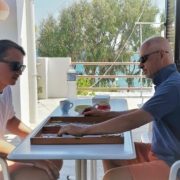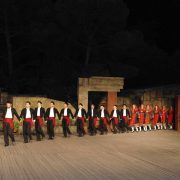Experiencing Orthodox and Catholic Easter the same year, is possible!
Greek Orthodox Easter is celebrated by most Greeks, all over the world. But many people are also experiencing two different Easters in one family, depending on their cultural backgrounds.
Pamela, an Omilo student from the USA, shared with us her article, which she shared with us about her longstanding tradition of celebrating two Easters, “wave upon wave”: “her Easter, ” at the Catholic church, and then the Eastern Orthodox Easter, at the church of her father’s family. Enjoy !
Omilo note;
1.For your info; in 2023 the Catholic Easter is celebrated on Sunday 9th of April, and the Greek Orthodox Easter on Sunday 16th of April.
2. The Omilo Easter course in Nafplion takes places during the Greek “megali evdomada”, the so-called “holy week”
3. The island of Syros might be an exception all over the world, where the Greek Orthodox population (around 60% of the island’s population) celebrates Easter together with the Roman Catholic population (around 40% of the island’s population). Every year, they celebrate Easter on the same day, the Greek Orthodox date, and in peace. Click here for more info about Syros island
Rejoice! It’s Easter.
Or is it?
As one Lent — the Lent of the West — leans into the finish line, another Lent — the Lent of the Orthodox East — is just warming up. Some years the two Easters fall on the same Sunday, but often, as a result of a centuries-old disagreement, they diverge. This year Eastern Orthodox Christians will celebrate “their” Easter four Sundays after “ours.”
At a round-table discussion among Orthodox and Roman Catholic leaders in Rome some decades ago, many expressed the hope that the two traditions might agree to a common date by the year 2,000.
If this discrepancy in dates is a scandal, as some hotly contend, it’s one my ecumenical family has been exploiting for years.
I grew up with a Lutheran mother and a Greek Orthodox father. When Easter came and then came again, we did them both — the first with a sunrise service outdoors and eggs dyed yellow, pink and blue; the second with hypnotic Byzantine melodies and eggs dyed blood red. In those days, men sat on one side of the Greek church, women on the other, and none of the service was in English. Knowing no Greek, I studied the sober faces of the icons that lined the walls.
As a young adult, I found Catholicism on my own — and later, with the help of my father’s family, rediscovered the Orthodox Easter liturgy. Today at our house, we celebrate “little Easter” (ours) and “big Easter” (theirs), going from one to the other as if riding a wave. If we fail to live up to our Lenten promises, we get a second chance. If the first liturgy disappoints, the second never does.
The Orthodox Easter vigil is a highly ritualized and awesome affair, beginning with chanted psalms and odes around 10:30 p.m. and lasting up to three hours. The mood shifts sharply just before midnight in anticipation of the resurrection liturgy. The church is darkened and silent as the priest lights a candle from the ever-burning vigil light on the high altar, chanting “Come ye and receive light … and glorify Christ who has risen from the dead.” Acolytes carry the flame solemnly from row to row, until all worshipers have lit the candles they received on entering the church.
When church is glowing and the priest has finished reading the resurrection story from the Gospel of Mark, the haunting, oft-repeated chant of the Easter hymn begins: “Christos anesti” — Christ is risen — the signal for worshipers, on their feet, to lift their candles high in the air, moving them up and down, right and left, in the sign of the cross.
Over and over as the service winds on, wrapping around more odes and readings and eucharistic prayers, the familiar hymn is sung in Greek — words meaning “Christ is risen from the dead, trampling down death by death, and bestowing life to those in the tombs.”
The service calls for endurance; occasionally someone faints. The parting thoughts, every year the same, are from the fourth century, a reading of the Easter sermon of St. John Chrysostom. At its heart is an inclusive message: “Ye rich and poor, rejoice together. Ye sober and slothful, celebrate the day. Ye that have kept the fast and ye that have not, rejoice today, for the table is richly laden. … Let no one mourn that he hath fallen again and again, for forgiveness has risen from the grave.”
Afterward, families gather to celebrate the end of their prescribed, rigorous 40-day fast (following the Orthodox Lent has a major impact on the daily diet.) We usually wend our way home as the sun is rising, keeping an eye out for deer.
We have become accustomed over the years, when the dates diverge, to extending Easter over two celebrations, giving it time to seep in and stay a while, to stir our imaginations, to renew our hopes. From a historical point of view, the timing of the feast, the day we gather in our churches to announce the news, may be grist for a fight. But on the spiritual plane it is irrelevant. The verb is present tense.
Listen as Orthodox Christians greet one another in the days following the Easter vigil:
Christos anesti. Christ is risen.
Alithos anesti. Truly he is risen.
By Pamela Schaeffer
+++++++++++++++++++++++
Are you curious and you would like to celebrate Orthodox Easter in Greece as well?
Then read our article about Celebrating Easter in Greece









